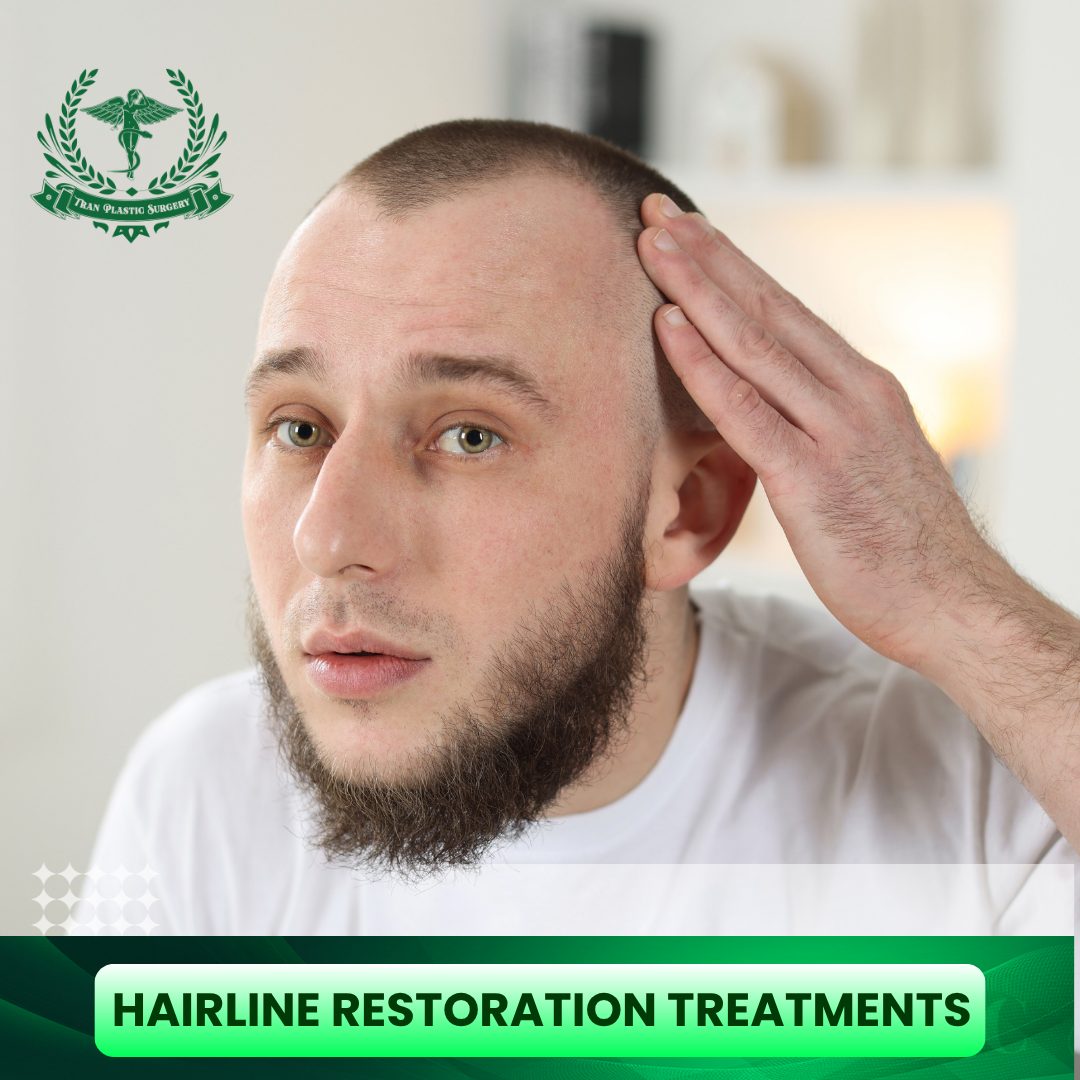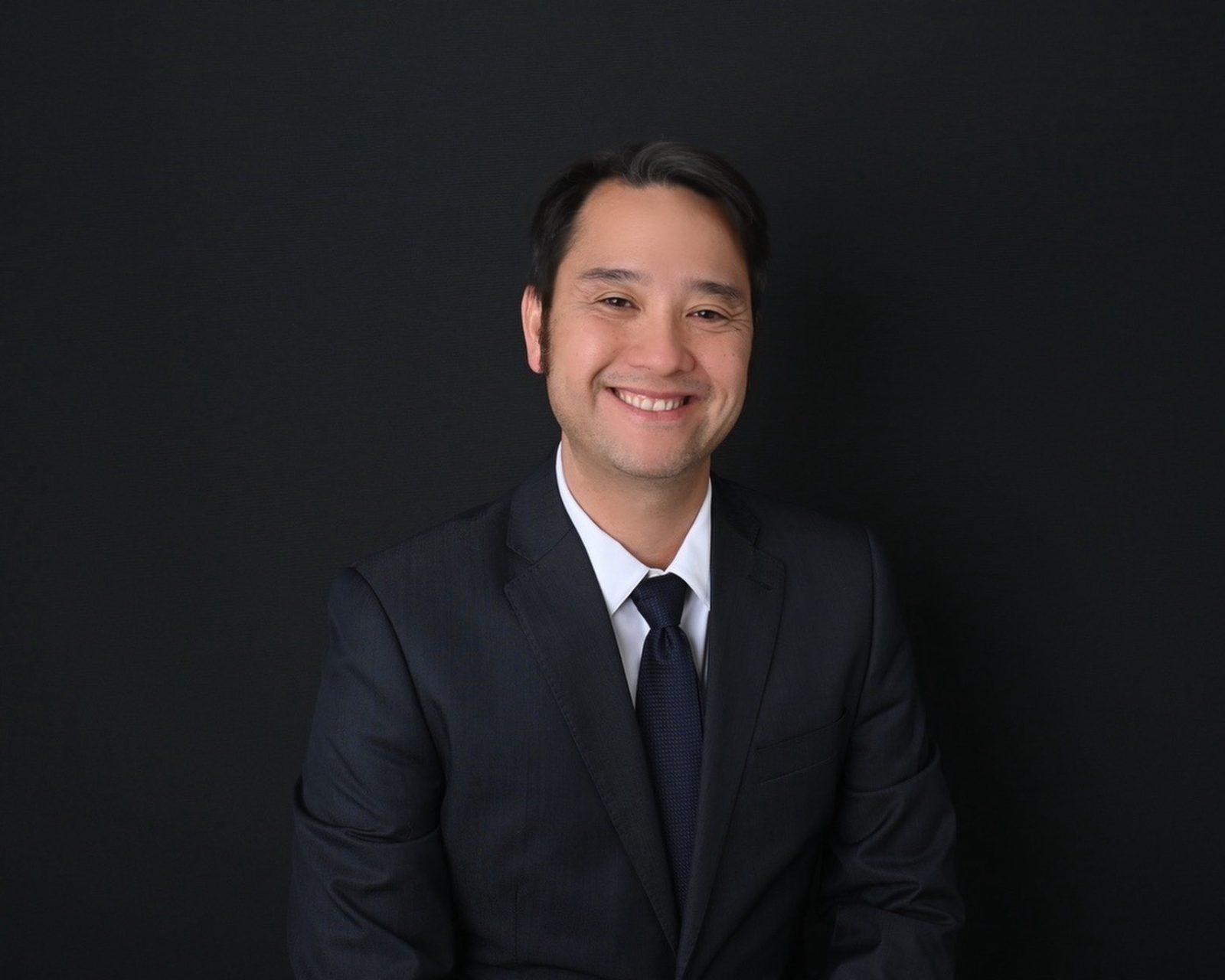Restoring a youthful, natural hairline requires a synergistic blend of surgical precision, technical expertise, and artistic vision. For individuals seeking to address hair thinning, a receding hairline, or significant hair loss, the path to successful hairline restoration involves careful evaluation of surgical techniques, personalized aesthetic goals, and a commitment to long-term maintenance. Modern hair restoration surgery provides permanent solutions that are virtually undetectable, provided the procedure is performed by a highly qualified specialist committed to the highest standards of care.
Table of Contents
ToggleThe Art and Science of Hairline Restoration: Defining Natural Results
Achieving a truly natural hairline extends far beyond simply moving hair follicles; it is a discipline rooted in anatomy, mathematics, and artistic gradation. The subtlety required to create a seamless transition between the forehead and the scalp demands specialized training and demonstrated experience, which is why verifying a surgeon’s credentials is non-negotiable for patients making such a high emotional and financial investment.
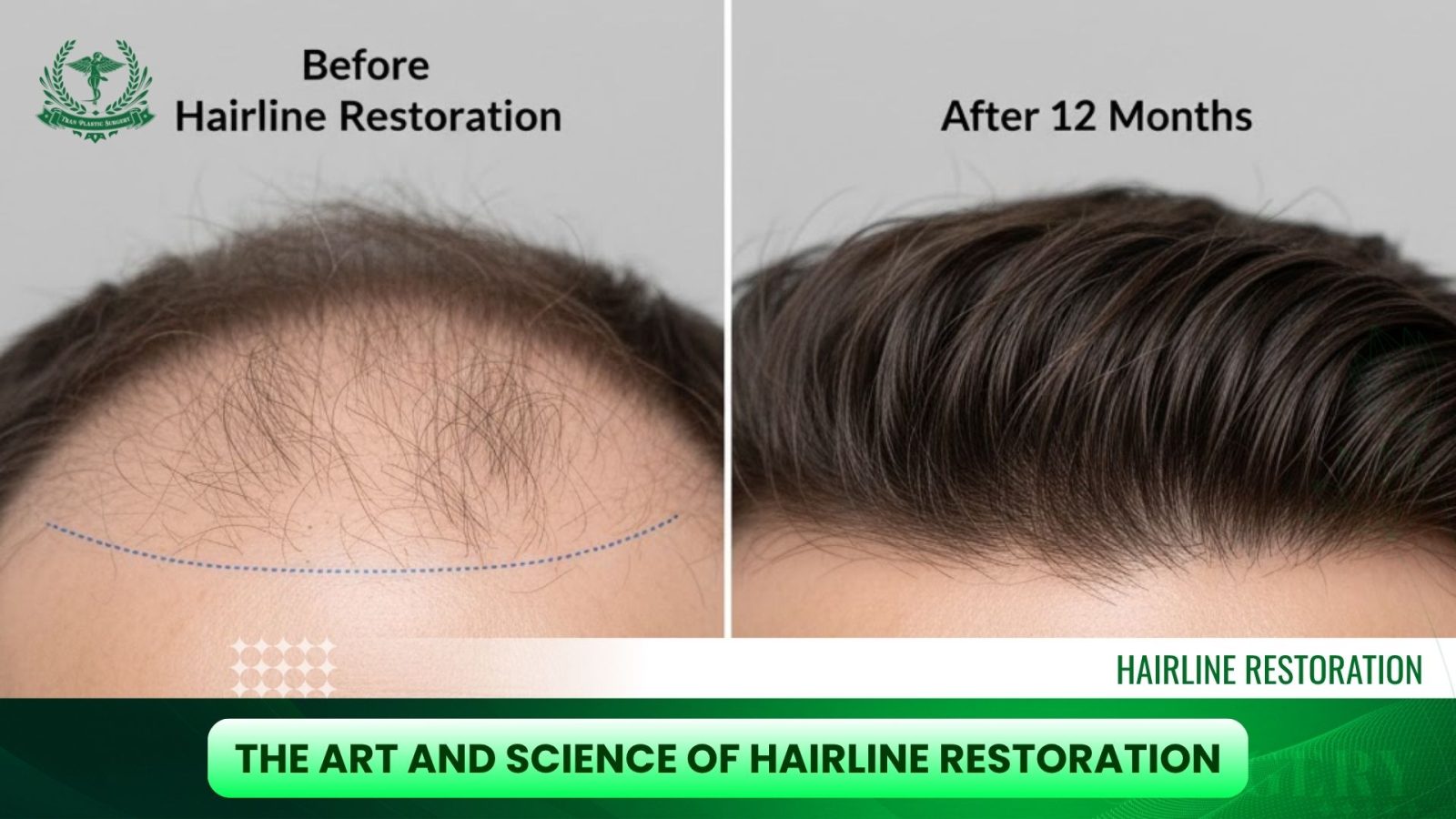
1. Why Surgeon Expertise is Non-Negotiable
The benchmark for expertise in this field is defined by the American Board of Hair Restoration Surgery (ABHRS). The ABHRS certification is the only psychometrically and statistically validated examination dedicated exclusively to the specialty of hair restoration surgery, and it is the only board certification recognized by the International Society of Hair Restoration Surgery (ISHRS), the largest educational society in the world dedicated to this field.
To become an ABHRS diplomate, a physician must provide rigorous documentation of their experience, including proof of three years of private practice focused on hair restoration surgery and case logs documenting the successful completion of a minimum of 150 hair restoration cases performed in the preceding three years. This extensive experience demonstrates that the specialist has mastered the complex artistry and technical skills necessary for consistent, high-quality outcomes. The ISHRS explicitly suggests that patients look for a doctor with a verified record of results, encouraging prospective patients to engage in deep discussions regarding the doctor’s specific suggestions for personalized hairline design.
2. Anatomy of an Undetectable Hairline: Density, Direction, and Gradation
An ideal, undetectable hairline is characterized by a gradual increase in density and a careful arrangement of hair growth angles. While a native, non-balding scalp typically holds 70 to 100 hairs per cm2, surgeons must work within the finite limits of the donor area and the scalp’s capacity to support new grafts.
2.1. Optimal Graft Density Parameters
Most standard hair transplant surgeries aim to re-implant hair at a density between 35 and 45 grafts per cm2. This density level typically achieves a natural result that blends effectively with existing hair styles, reflecting approximately 50 to 60 percent of the natural hair density.
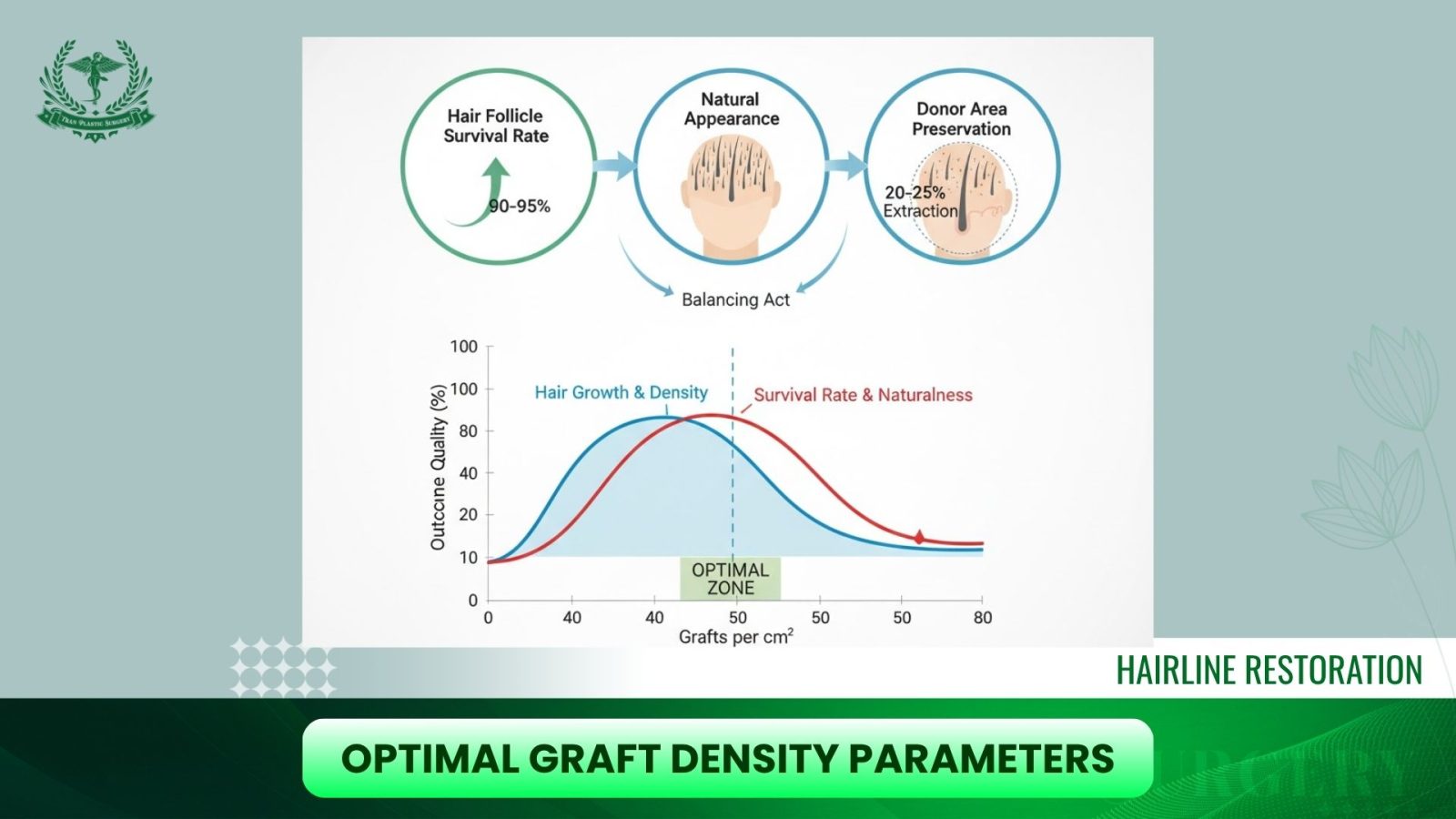
However, the pursuit of the best hairline restoration often involves a technique known as high-density hair transplantation for the frontal aesthetic zone. This procedure involves implanting grafts at a density between 50 and 60 grafts per cm2, which is intended to closely mimic 70 to 80 percent of natural hair density, making the difference between native and transplanted hair virtually undetectable.
2.2. The Illusion of Density
A highly skilled hair transplant surgeon understands the principle of the “illusion of density.” Because the donor area is finite, maximizing coverage and optimal fullness requires strategic planning. This involves harvesting hair follicles from donor areas known for thicker hair, such as the occipital region (back of the head). By implanting these thicker grafts strategically, the surgeon creates the impression of fullness without needing to implant excessively high amounts of follicular grafts across the entire recipient area, which might otherwise deplete the donor supply or cause trauma.
2.3. Safety and Biological Limits
Achieving high density is not straightforward and is governed by strict biological constraints. The choice to implant hair at high density must be balanced with the inherent risks of vascular compromise. Attempting to transplant grafts beyond the 60 grafts per cm2 range is considered clinically risky, as it pushes the physical limit of how close hairs can be successfully implanted. Implanting follicles too closely creates “graft competition” where the newly implanted hairs vie for limited blood supply, often resulting in poor graft survival and the hair failing to grow.
Furthermore, aggressive, high-density implantation severely increases the risk of skin necrosis (skin death) due to over-traumatization and restriction of the skin’s vital blood flow. This complication results in significant damage and failure of the grafts to grow. This clinical constraint underscores why the initial hairline restoration price is directly linked to the safety margin provided by experienced surgeons; less experienced providers may attempt dangerous high densities to meet unrealistic patient demands, sacrificing patient safety for perceived density.
Patients with a history of smoking are particularly at risk of impaired wound healing and should not undergo high-density hair transplant surgery, as smoking increases the probability of skin necrosis. Thus, lifestyle factors directly dictate the maximum achievable, safe density level, irrespective of the surgeon’s technical skill or the abundance of the donor supply.
>>> This article is for you: Why Am I Losing Hair? Common Causes & Hair Thinning Treatments
Comprehensive Hairline Restoration Surgery: The Core Techniques
Hairline restoration surgery is the only permanent method to restore receding hairline features that have been lost due to genetic factors.8 The selection of the technique is critical, influencing the resulting density, scarring profile, recovery time, and, ultimately, the final aesthetic outcome.
1. Follicular Unit Extraction (FUE) and Direct Hair Implantation (DHI)
1.1. FUE: The Minimally Invasive Standard
Follicular Unit Extraction (FUE) is the preferred minimally invasive technique for modern hairline restoration. In FUE, individual follicular units (grafts) are extracted directly from the donor area using a small punch tool. This method is favored for its quicker recovery time patients can often resume daily activities within a few days and its minimal scarring profile. FUE leaves tiny, dot-like scars scattered across the donor scalp, which are often undetectable, even with short hairstyles. Advanced FUE techniques, when managed by an experienced team, can now match or even surpass traditional methods in graft yield while simultaneously minimizing trauma to the donor area.
1.2. DHI: Precision for the Perfect Hairline
Direct Hair Implantation (DHI) is an advanced evolution of the FUE method, distinguished by its unique implantation technique. DHI utilizes a specialized tool known as the DHI Implanter or Choi pen. Unlike traditional FUE, which requires the surgeon to create incisions (slits) in the recipient area before inserting the grafts, DHI allows for the direct implantation of the follicle into the scalp without prior incision creation.
This direct approach grants the surgeon total, meticulous control over three crucial variables: the depth, the direction, and the precise angle of placement. The ability to dictate the micro-angle of each graft is paramount for achieving a seamless, natural-looking hairline, especially in the frontal 1–2 cm2 where the hair angle must be shallow and forward-facing to create the wispy transition zone. The DHI technique results in reduced scalp trauma and enables high precision in graft placement, yielding a denser and more natural growth pattern. While DHI procedures can be more time-consuming than standard FUE, the increased precision makes DHI a highly sought-after option for maximizing density and achieving superior hairline definition.
2. Follicular Unit Transplantation (FUT): Strategic Use for Max Coverage
Follicular Unit Transplantation (FUT), sometimes referred to as strip surgery, involves removing a strip of scalp skin from the donor area (usually the back of the head) to harvest follicular units. FUT remains a relevant surgical option, primarily because it allows for the harvest of a significantly larger number of grafts in a single session compared to FUE or DHI. This characteristic makes FUT highly suitable for patients requiring extensive grafting or those who need to achieve greater density and coverage rapidly, often in non-aesthetic zones like the crown.
However, the primary trade-off with FUT is the resultant linear scar at the donor site where the strip was removed. This scar can be visible, particularly if the patient chooses to wear their hair short. From a financial perspective, FUT is generally considered more cost-effective per graft than FUE or DHI.
3. The Critical Role of Surgical Artistry: Maximizing Density Safely
The difference between a restoring hairline procedure and a truly natural result often comes down to the surgeon’s mastery of graft placement and density management. For the frontal hairline edge, meticulous control over angulation is key. The hair should exit the scalp at a very shallow, acute angle and change direction naturally as it moves laterally and posteriorly. Techniques like DHI are particularly beneficial in this crucial 1–2 cm2 zone because they facilitate the highest consistency in micro-angles, which is essential for creating the soft, gradient edge that defines a natural result.
The surgical team must always adhere to the biological limitations of the scalp. As established, attempting to push density past the 60 grafts per cm2 range dramatically increases the risk of complications, including graft failure and skin necrosis. The most sophisticated approach often involves a combined strategy: utilizing the precision of DHI or advanced FUE for the aesthetically critical hairline zone, and potentially using FUT only if maximum graft count is necessary for coverage in the crown or mid-scalp, thereby optimizing both cosmetic outcome and cost efficiency. The following table compares the modern techniques:
| Technique | Scarring Profile | Primary Benefit | Ideal Scenario | Cost per Graft (USA Est.) |
| FUE (Follicular Unit Extraction) | Minimal (Dot Scars) | Faster recovery, flexibility for short hair | Moderate hair loss; short hair preference | $4.00 – $12.00$ |
| DHI (Direct Hair Implantation) | Minimal (Dot Scars) | Maximal precision (angle, depth, density) | Hairline restoration/refinement; dense packing | Higher than standard FUE (Time-intensive) |
| FUT (Follicular Unit Transplantation) | Linear Scar | Highest number of grafts in one session | Extensive baldness; high density required in non-aesthetic zones | $3.00 – $8.00$ |
Customizing Restoration: Gender and Ethnic Specificities
Effective hairline restoration is inherently customized. A successful procedure must account for profound aesthetic and biological differences between male and female hairlines and must adapt technical methods for unique hair textures, such as Afro-textured hair.
1. Men’s Hairline Restoration: Defining Masculine Contours

Men typically seek hair transplants to aggressively restore a defined, receding hairline or to cover balding areas on the crown, aiming for a more youthful look that suits their facial structure. The aesthetic goal involves creating a strong frontal line that is characteristically M-shaped, often with strategically receded temporal points.
Surgical artistry in men’s hairline restoration requires designing a line that is both defined and age-appropriate. Designing a hairline that is too low can appear unnatural, especially as the patient ages. Surgeons must balance the patient’s desire for a youthful appearance with a conservative design that anticipates the inevitable progression of hair loss in native areas, ensuring long-term aesthetic harmony.
2. Hairline Restoration Women: Density and Proportionality
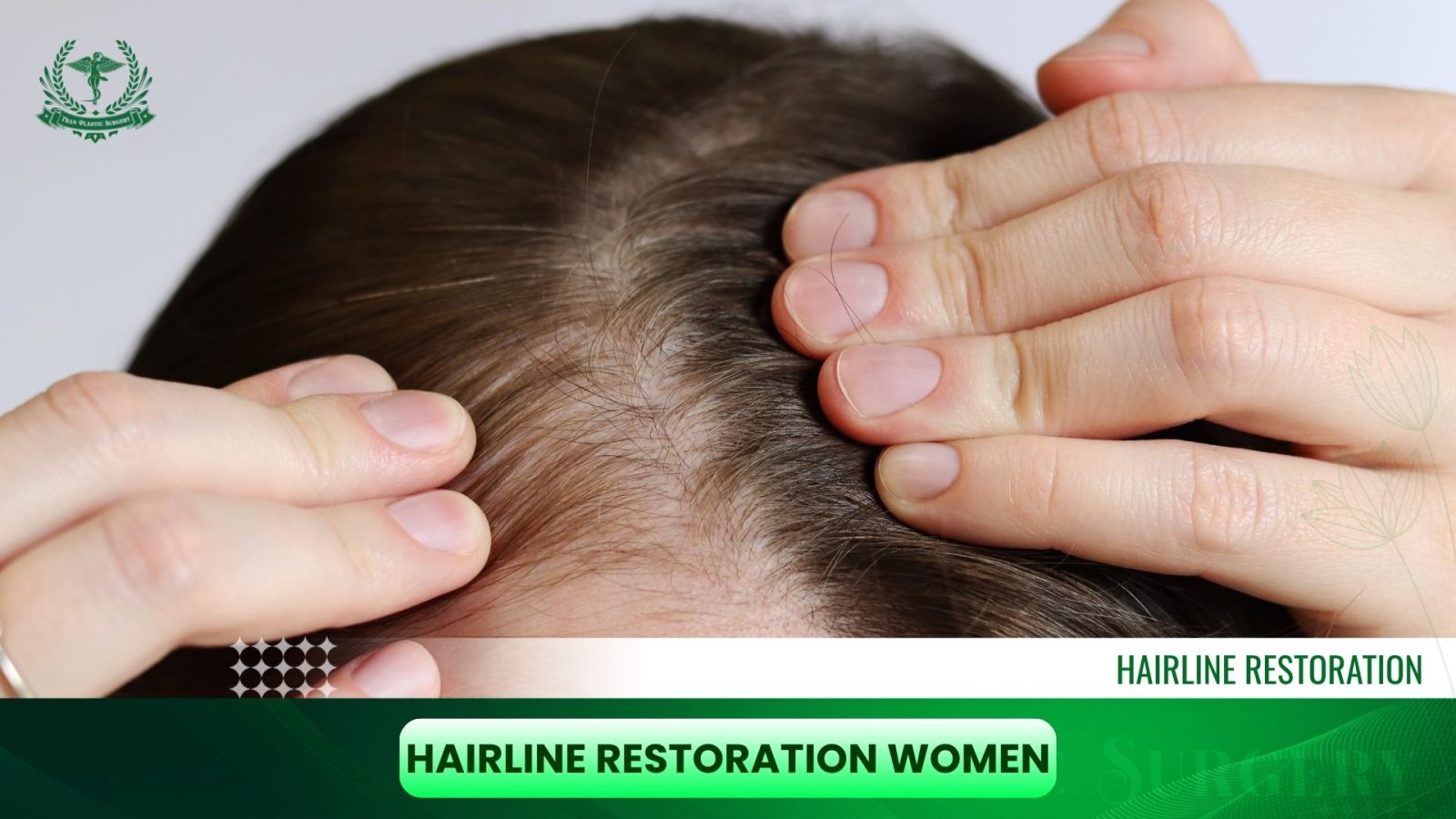
The goals for hairline restoration women are fundamentally different from those for men. Women typically seek to increase overall hair density, particularly in thinning areas, focusing on volume and coverage to maintain a feminine appearance rather than restoring a defined, low hairline. The female hairline is generally designed to be lower, softer, and more rounded, maintaining a uniform density across the frontal zone without the sharply receded temples seen in male designs.
2.1. Hairline Lowering Options for Women
For women whose primary concern is a naturally high forehead that affects facial proportions, two main options exist: hair transplantation focused on lowering the hairline, or surgical hairline lowering (forehead reduction).
Forehead reduction surgery physically advances the existing scalp, providing immediate and permanent improvement in facial balance. A critical advantage of this procedure is that it brings the patient’s existing, fine, wispy natural hairs forward. Because a truly natural hairline transition zone is composed of these fine vellus hairs, forehead reduction often provides a more seamless and natural-looking edge than relying purely on transplanted, generally thicker, donor hair.
In cases where women require both significant lowering and density improvement (for example, to fill in thinning temporal points or the frontal hairline itself), a hybrid approach may be utilized. This involves performing surgical advancement first, followed by hair transplantation to refine the density along the new hairline, delivering the most natural and lasting aesthetic outcome while protecting the donor area. This combined strategy is often the most refined method for patients seeking optimal density and proportion.
| Design Aspect | Mens Hairline Restoration | Hairline Restoration Women |
| Contour Shape | Defined, often M-shaped or slightly receded temples | Lower, softer, rounded contour with uniform density |
| Primary Goal | Define the hairline; cover crown/receding temples | Increase overall density; lower the forehead for facial balance |
| Surgical Note | Often requires more grafts for definition | Focus on strategic, dispersed grafts for volume; may combine with surgical lowering |
3. Black Hairline Restoration: Addressing Unique Challenges
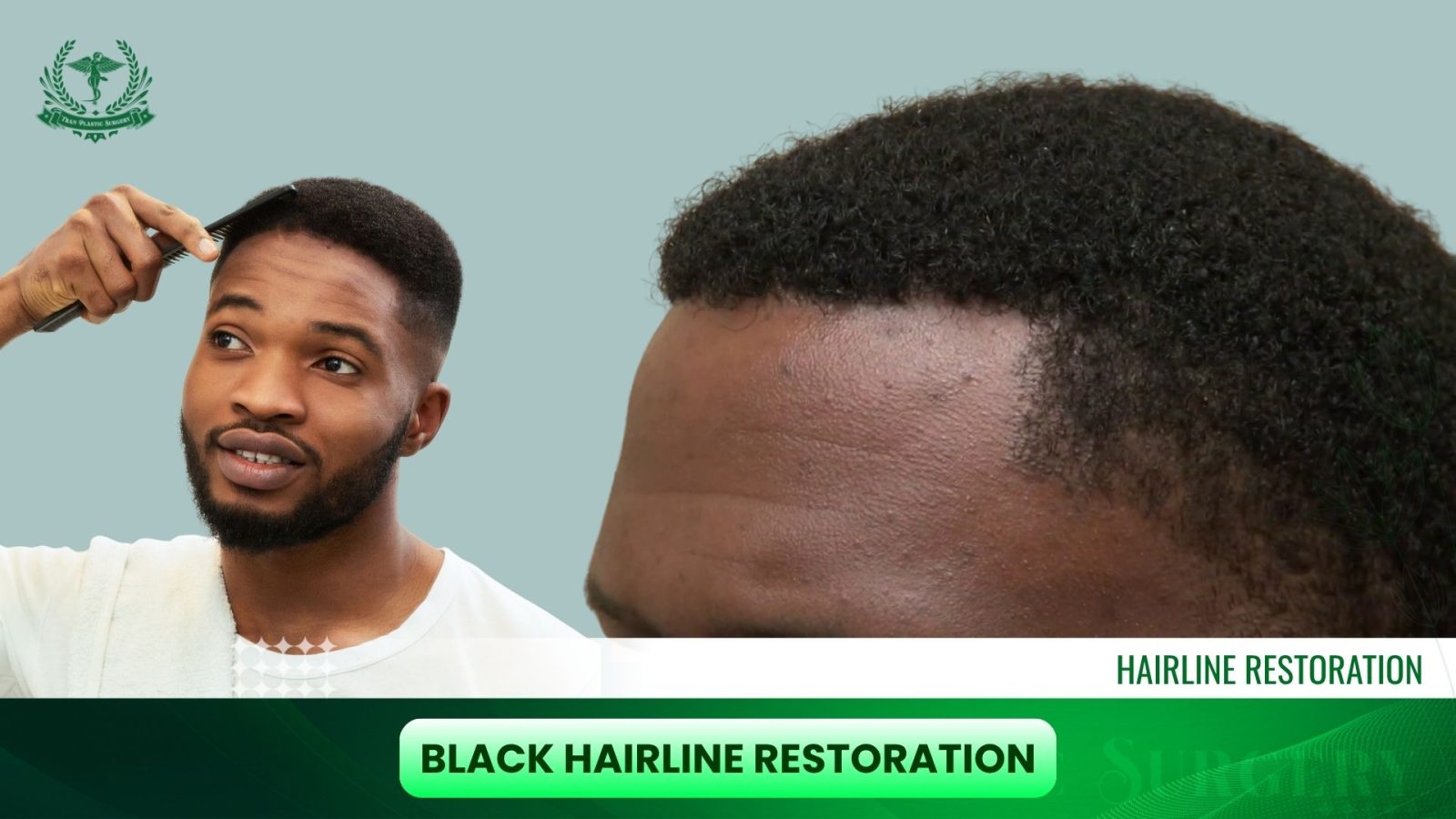
Black hairline restoration requires exceptional technical skill and specialized equipment due to the unique anatomical characteristics of Afro-textured hair. The curved, C-shaped structure of the follicle beneath the scalp poses a significant challenge, resulting in a high risk of hair transection (damage to the follicle during extraction) if standard techniques are used. If the curved hair follicle is damaged during extraction, its growth may be stunted, leading to an unsuccessful transplant.
3.1. Specialized FUE Techniques
For these cases, the standard of care moves beyond generic FUE to highly specialized, curl-adapted FUE. Research has demonstrated that conventional sharp or dull rotary punches frequently lead to failure, with transection rates climbing as high as 90 percent. To overcome this, expert surgeons utilize specialized non-rotary curved punches, which are designed to accommodate the curliness of the hair. Clinical data confirms that the use of a non-rotary curved punch can successfully reduce transection rates to below 5 percent. Patients should specifically inquire whether a potential surgeon utilizes such curl-adaptive FUE techniques, as the specific tool used is a non-negotiable component of maximizing clinical efficacy.
3.2. Placement and Dermatological Risks
Successful implantation also demands careful spacing. Due to the volume taken up by the curly hair follicle underneath the scalp, grafts should not be placed in very close proximity, as overcrowding can compromise growth.
Furthermore, individuals with thick, darker skin, such as those of African descent, face an increased risk of post-operative keloid formation (raised, thick scarring) compared to Caucasian or Asian skin. FUE is generally preferred over FUT for African American hair because it results in minimal dot scarring rather than a linear scar. Expert surgeons must employ proper surgical techniques and prescribe stringent post-operative care protocols to minimize the chance of keloid scarring and ensure the desired outcome.
Non-Surgical Pathways: Preventing Loss and Sustaining Results
Surgical intervention permanently restores hair to the desired hairline, but the long-term, natural appearance of the restored hairline relies heavily on the maintenance of the surrounding native hair. Without intervention, native hair loss will continue due to genetic factors, potentially isolating the transplanted zone and compromising the overall aesthetic outcome. Therefore, achieving the best hairline restoration is a lifelong commitment, not a one-time surgical event.

1. The Pharmacological Foundation: Minoxidil and Finasteride
The synergistic use of FDA-approved pharmacological agents is the bedrock of long-term hair maintenance.
1.1. Finasteride (Propecia)
Finasteride is a prescription oral medication specifically for men. It works by addressing the underlying hormonal cause of male pattern baldness, the effect of dihydrotestosterone (DHT) on hair follicles. By inhibiting the production of DHT, finasteride slows genetic baldness, prevents additional shedding of native hair, and maintains overall hair density, ensuring a uniform and natural look.
1.2. Minoxidil (Rogaine)
Minoxidil is an over-the-counter topical solution or foam, applicable for both men and women experiencing early to moderate thinning. It works by enhancing blood circulation in the scalp, delivering more oxygen and nutrients to the hair roots, which stimulates follicles and extends the hair’s growth phase. It encourages both native and transplanted hair to grow faster and thicker.
3. Combined Therapy Post-Surgery
The combination of Finasteride and topical Minoxidil has been shown to be more effective than using either therapy alone, as Finasteride targets the hormonal cause while Minoxidil optimizes the follicular environment. Hair transplant specialists strongly recommend continuing these therapies post-surgery. While transplanted grafts are genetically resistant to DHT, the surrounding native hair remains vulnerable. Stopping these treatments may lead to noticeable thinning in untreated areas, undermining the appearance of the restored hairline.
2. Advanced Regenerative and Light Therapies
For patients seeking to further enhance growth or for those who prefer non-pharmacological options, advanced regenerative therapies are highly effective.
2.1. Platelet-Rich Plasma (PRP) Therapy and Microneedling
Platelet-Rich Plasma (PRP) therapy involves injecting a concentrated serum of the patient’s own platelets (rich in growth factors) directly into the scalp to stimulate hair follicle activity and repair. This process strengthens miniaturized hairs, slows shedding, and improves density.
Microneedling complements PRP by physically stimulating the scalp through controlled micro-injuries. This mechanical stimulation induces collagen production and follicle regeneration. Crucially, the micro-channels created by microneedling significantly enhance the absorption of topical agents, including PRP, allowing the growth factors to penetrate deeper into the scalp. Clinical research has demonstrated the powerful synergy of this combined approach: studies have found that combining microneedling with Minoxidil increased hair counts up to four times higher compared to Minoxidil use alone. This combination provides a comprehensive and highly effective solution for hair regrowth.
2.2. Low-Level Laser Therapy (LLLT)
Low-Level Laser Therapy (LLLT) is an FDA-cleared, non-invasive technology for treating hereditary hair loss in both men and women. LLLT devices use coherent monochromatic red light (typically 650 nanometers) to stimulate cellular activity, increasing blood flow to the hair follicles and triggering them to shift into the active growth (anagen) phase.
LLLT is a painless, at-home treatment that requires no recovery time and is associated with minimal side effects. Clinical trials have confirmed that LLLT stimulates hair growth and improves hair density, making it an excellent supportive therapy for individuals with mild to moderate hair loss or those looking to strengthen existing hair following a transplant.
Financial and Logistical Planning: Hairline Restoration Cost and Accessibility
Understanding the hairline restoration cost is crucial for patient planning. The procedure represents a significant investment, reflecting the highly specialized nature of the surgery, the time-intensive techniques used, and the surgeon’s required level of expertise.
1. Understanding Hairline Restoration Price in the USA Market
The hairline restoration price is determined by several complex factors: the total number of grafts necessary to achieve the desired density, the technical method used (FUE, DHI, or FUT), the geographic location of the clinic, and the expertise and reputation of the hair restoration surgeon.
1.1. Graft Pricing Structure
Hair restoration procedures are priced per graft. A graft is a follicular unit containing, on average, one to four hair follicles.
In the USA market, the cost per graft varies based on the technique:
- FUE/DHI Cost: FUE is generally more expensive due to its labor-intensive, precise nature, averaging $4.00 to $12.00 per graft.
- FUT Cost: FUT is more affordable, ranging from $3.00 to $8.00 per graft, reflecting the faster extraction speed of the strip method.
The consistently higher pricing of FUE and DHI directly reflects a market trend prioritizing minimal scarring and superior cosmetic refinement, confirming that patients are willing to pay a premium to ensure their hairline restoration results are truly undetectable.
1.2. Total Procedure Costs
For patients in the United States, the total cost for a moderate hairline restoration procedure often requiring 1,500 to 2,500 grafts averages between $8,000 and $25,000 or more, depending on the complexity. For example, 2,500 grafts average approximately $13,610 in the US.
| Metric | FUE Cost Range (USD) | FUT Cost Range (USD) | 2,500 Grafts (Estimated Total) |
| Price Per Graft | $4.00 – $12.00$ | $3.00 – $8.00$ | N/A |
| 1,000 Grafts | $4,000 – $7,000$ | $3,500 – $6,000$ | N/A |
| Average Total Procedure | $8,000 – $25,000+$ | $6,000 – $15,000$ | $10,000 – $18,000$ |
2. Making Hairline Restoration Accessible: Financing Options
Most insurance providers classify hair restoration procedures as cosmetic and do not provide coverage, although exceptions exist if the hair loss is caused by trauma, scarring, or a defined medical condition. Given the high cost of highly specialized surgery, robust financing solutions are crucial for making quality hairline restoration near me accessible to more patients.
Many reputable clinics partner with third-party medical finance companies to offer flexible payment plans. These plans often feature options such as 0% interest for shorter promotional periods (e.g., 6, 12, or 24 months) or extended, fixed-rate loans spanning terms up to 84 months. These payment structures allow patients to manage the significant financial commitment without undue burden, ensuring they can access the specialized care necessary for safe, permanent results.
Long-Term Success and Maintenance Protocols
The success of restoring hairline function is ultimately measured by the long-term survival and natural integration of the transplanted follicles. This outcome is heavily dependent on adherence to strict post-operative protocols and careful patient selection.
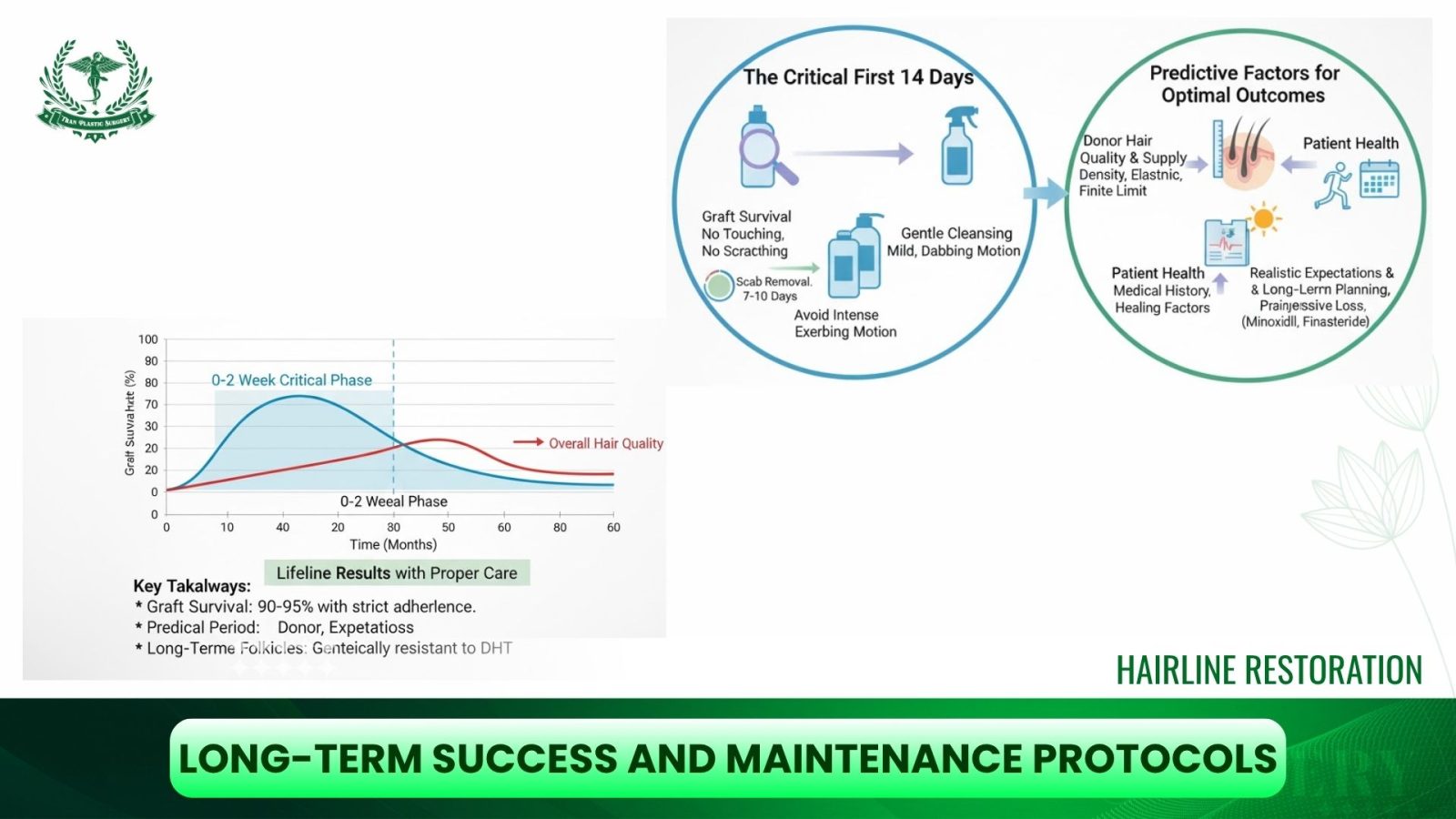
1. The Critical First 14 Days: Ensuring Graft Survival
The immediate post-operative period is the most critical time for ensuring high graft survival rates. Grafts are highly fragile and susceptible to dislodgment during the first few days. Patients must meticulously avoid touching, pressing, or scratching the transplanted area.
Cleansing and Protection
Gentle cleansing typically begins on the second day post-surgery. A specialized, mild, pH balanced shampoo and a foam or lotion are used daily. The lotion must be applied and allowed to soak for 15 to 30 minutes to soften the scabs around the newly transplanted grafts. The scalp is then washed gently using a dabbing and patting motion, never scrubbing or rubbing to gradually remove the scabs without dislodging the grafts. Complete scab removal is usually achieved within 7 to 10 days. This careful scab management is not merely cosmetic; it is a clinical necessity that reduces the risk of infection, optimizing the conditions for successful follicular anchoring.
Patients must also follow strict rules regarding activity and environmental exposure. Intense physical exercise should be avoided for approximately one month, and swimming is prohibited for at least two weeks to prevent infection. Sun protection is mandatory: direct sunlight must be avoided for the first two weeks, and protective headwear should be worn whenever outdoors for up to six months, as the scalp remains highly sensitive to burns.
2. Predictive Factors for Optimal Outcomes
The longevity and natural appearance of the outcome are dictated by three primary factors assessed during the initial consultation:
- Donor Hair Quality and Supply: The condition, density, and elasticity of the donor area determine the total number of grafts that can be safely harvested without compromising the donor site. The donor supply is finite, placing a natural limit on achievable density.
- Patient Health: A patient’s overall health and medical history, particularly conditions that impair blood clotting or healing, must be managed prior to surgery to secure successful outcomes and reduce complications.
- Realistic Expectations and Long-Term Planning: The surgeon has an ethical responsibility to gauge expectations against realistic outcomes based on the patient’s individual hair loss pattern (often assessed using the Norwood Scale for men). Since hereditary hair loss is progressive, the surgeon must design a hairline that will continue to look natural even if the surrounding native hair thins over the subsequent years. This requires an understanding of long-term hair loss prediction and a commitment to recommending permanent maintenance protocols (Minoxidil and Finasteride) to protect the aesthetic investment. With proper care, transplanted follicles are genetically resistant to DHT and can last a lifetime.
Tran Plastic Surgery’s Commitment to Natural, Lasting Results
Achieving truly natural hairline restoration requires an intersection of clinical expertise, specialized technology, and dedicated long-term care. Tran Plastic Surgery prioritizes the rigorous standards necessary for outstanding results, offering highly individualized treatment plans for every patient seeking to restore hairline density and definition.

For both men and women, the focus is on utilizing advanced techniques like DHI and Advanced FUE to ensure precise placement and angulation in the frontal zone. For specialized cases, such as black hairline restoration, the practice employs curl-adapted FUE tools and keloid management strategies to guarantee high graft survival and minimal scarring. The surgical plan always incorporates strict safety measures, including adhering to biologically safe density limits (50–60 grafts per cm2) and carefully screening patients for risk factors like smoking history, which could impair healing.
The restoration process is finalized through a strong commitment to non-surgical maintenance. The longevity of the aesthetic outcome depends on protecting the native hair through recommended therapies such as Minoxidil, Finasteride, and combined PRP/Microneedling protocols. This comprehensive, expert approach ensures that the hairline restoration is not only successful today but remains aesthetically harmonious for decades to come.

